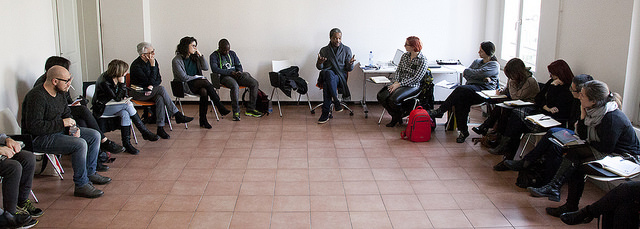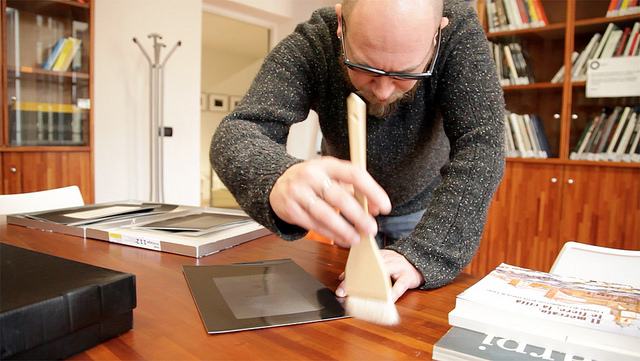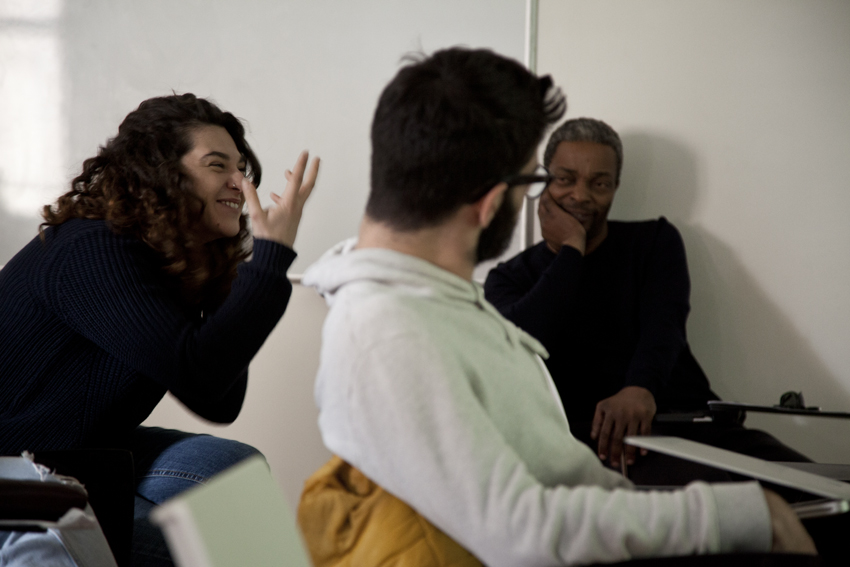"Heterochrony"
Conductor:Simon Njami

For the first time the AtWork workshop dealt entirely with the photographic image, involving the aspiring photographers, videoartists and curators. The workshop, full of stimuli and inspirations, engaged the students in a “critique session” of their own productions and concluded with the inauguration of the personal show of the photographer Santu Mofokeng, the winner of the International Prize for Photography 2016.
“Photography is the space of heterochrony. It’s the space that is dealing with different time at the same time. The moment I see the image I want to take and the moment I click on my camera are already two different times and when someone would be looking at the image it would be yet another time. So photography for me was the perfect platform, the perfect example to deal with heterochrony.”
Simon Njami, AtWork Modena leader
AtWork Modena workshop was implemented in partnership with Fondazione Fotografia Modena and involved 21 students from the first and second year of the Master in Advanced Training in Contemporary Imagery and the Curating Course students, as well as an aspiring photographer Mohamed Keita from Ivory Coast, who was invited as a guest. For this new AtWork chapter Simon Njami has chosen as main theme “Heterochrony”, or breaking the real time continuum, introducing the multiple space-time dimension through which to reconsider the artistic practice and the art fruition. On March 6th Fondazione Fotografia Modena also announced the South African photographer Santu Mofokeng as the winner of the International Photography Prize 2016. Mofokeng’s solo exhibition curated by Simon Njami inaugurated at Foro Boario in Modena on the last day of the workshop, so the students could immediately see the practical implications of what they have learned about “heterochrony” through the timeless photography of the master Mofokeng.
“During the workshop all of us, the photography and videoart students, were constantly put against the wall, forced to question all our certainties and principles, goals and big loves. Urged to look deeply inside ourselves, with and without photo and video cameras, and to do what we are rarely willing to do anymore: to consider the things from other perspectives.”
Sara Vighi, AtWork Modena participant

Photo by Aida Muluneh
Simon Njami is an independent curator, lecturer, art critic, and writer. He is the co-founder and editor-in-chief of “Revue Noire.” Previously, Njami was the artistic director of the Bamako Photography Biennial 2000-2010, and co-curator of the first African pavilion at the 52nd Venice Biennale in 2007. He has curated a number of contemporary art and photography exhibitions, including Africa Remix (2004-2007) and the first African art fair in Johannesburg in 2008. In 2014, The Divine Comedy exhibition, created and curated by him, started a world tour at the MMK (Museum für Moderne Kunst) in Frankfurt, moving on to the SCAD Museum of Art in Savannah and the Smithsonian Museum of African Art in Washington, DC. He is the director of the Pan African Master Classes in Photography, a project created in partnership with the Goethe Institute; artistic director of the Donwahi Foundation (Abidjan, Ivory Coast); adviser to the Sindika Dokolo Collection (Luanda, Angola); secretary of the special jury of the World Press Photography Awards; artistic director of the first edition of Off Biennale (Cairo, 2015) and the 2016 Dak’Art Biennale (Dakar, Senegal), the first and most important artistic event in Africa.
“If all the fundamentalists or colonizers in the world had read something about heterochrony the world would have been different. Because heterochrony would have taught them that there is no way you can impose your time on somebody else’s time.”
Simon Njami, AtWork Modena leader

After the first collective discussion on the workshop’s theme “Heterochrony” that opened the infinite possibilities for reflections, the students have been invited to produce the photographic images that would break their usual working method and space-time continuum. They had to go outside and produce an image that combined many different times and places, times different from the present, a heterochronic image. Following this deconstructive input, which was meant to shift the gaze on the subjects they have not previously experienced, the students had a chance to prolong the time of reflection for a few weeks after the end of the workshop, using the Moleskine notebooks as diaries or time machines that would collect all the inspirations gathered from breaking the space and time continuum. The final project is to tell “a particular day” through the heterochronic images.
